Canterbury Cathedral, St. Augustine's Abbey and St. Martin's Church represent the rebirth of Christianity to Great Britain. Canterbury Cathedral is one of the oldest and one of the most famous cathedrals in England. The cathedral is the seat of the Archbishop of Canterbury, the leader of the Church of England. Canterbury Cathedral was founded by the Benedictine monk Augustine in 597. The cathedral was severely damaged during Viking raids. The cathedral was completely rebuilt after a fire in 1067. The crossing tower, the western transepts and nave of the cathedral were built in the English Gothic style, also known as the Perpendicular style. There have been many additions to the cathedral over the last nine centuries. Archbishop Thomas Becket was murdered in Canterbury Cathedral in 1170. He was buried in Canterbury Cathedral. Soon after the death of Thomas Becket, Canterbury Cathedral became the most important pilgrimage destination in Great Britain. His tomb was destroyed in 1538, on the orders of King Henry VIII. Canterbury was bombed during World War II, the cathedral escaped with minor damage. Canterbury Cathedral is part of the UNESCO World Heritage: Canterbury Cathedral, St. Augustine's Abbey and St. Martin's Church. Canterbury Cathedral, St. Augustine's Abbey and St. Martin's Church were declared a UNESCO World Heritage in 1988.
www.werelderfgoedfotos.nl © Copyright World Heritage Photos Classic Car Road Trip
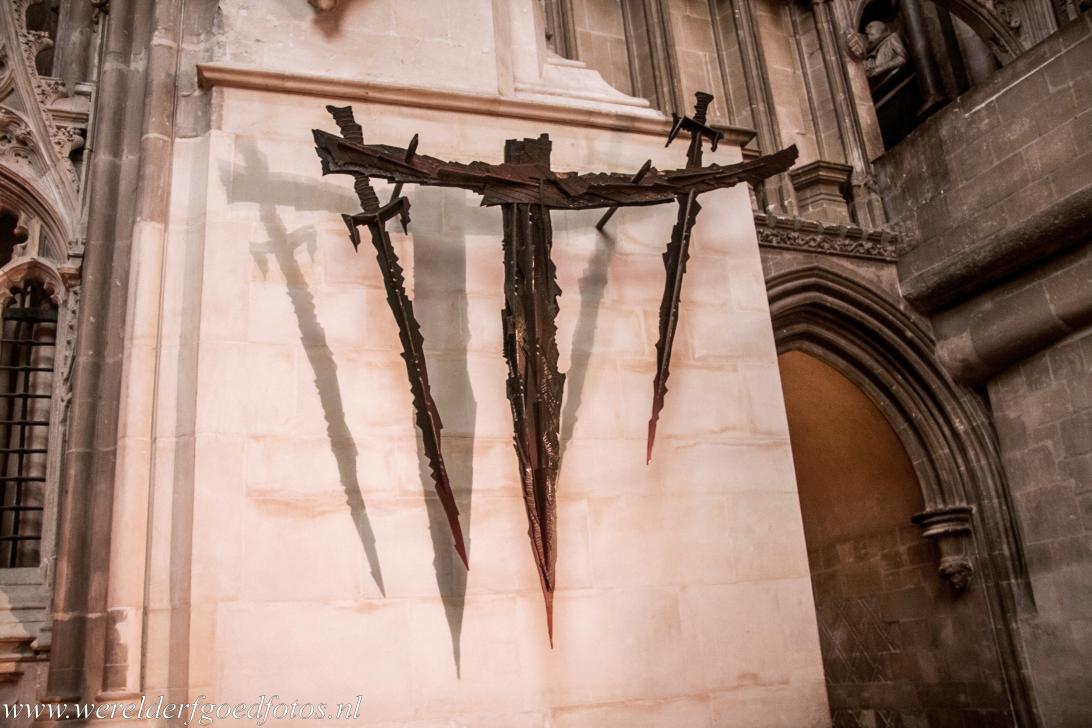
Canterbury Cathedral: The Martyrdom of Thomas Becket, the place where Archbishop Thomas Becket was murdered in 1170. Soon after the death of Thomas Becket, the cathedral became a major pilgimage destination in Great Britain and far beyond. Thomas Becket was buried inside Canterbury Cathedral and pilgrims regarded the shrine of Thomas Becket as a place of healing. Canterbury Cathedral was inscribed on the UNESCO World Heritage List in 1988.

Canterbury Cathedral: The Martyrdom of Thomas Becket, the place where Archbishop Thomas Becket was murdered in 1170. Soon after the death of Thomas Becket, the cathedral became a major pilgimage destination in Great Britain and far beyond. Thomas Becket was buried inside Canterbury Cathedral and pilgrims regarded the shrine of Thomas Becket as a place of healing. Canterbury Cathedral was inscribed on the UNESCO World Heritage List in 1988.
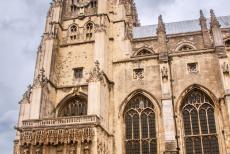
Canterbury Cathedral is situated behind the 16th century Christ Church Gate, the main gateway to the cathedral. The formal title of the cathedral is the Cathedral and Metropolitical Church of Christ at Canterbury. Canterbury Cathedral belongs to the UNESCO World Heritage: Canterbury Cathedral, St Augustine's Abbey and St Martin's Church.
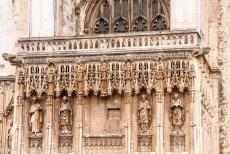
The sculptures above the southwest porch of Canterbury Cathedral, the Gothic southwest porch was built in the 15th century, the porch is adorned with the statues of archbishops. The statues date from the 1860s. The statue on the left hand side represents St. Augustine, the Benedictine monk who became the first Archbishop of Canterbury in 597.
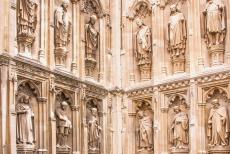
Canterbury Cathedral: The statues next to the south porch. Most of the statues that adorn the cathedral were created in the 1860s, they represent the most influential figures in the history of the cathedral, such as members of the royal family, theologians and the clergy, among them the statues of St. Augustine and Queen Bertha of Kent and Queen Victoria.
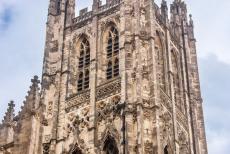
The renowned Bell Harry Tower of Canterbury Cathedral was completed in 1498. The cathedral has twenty one bells in three towers, among them is the Great Dunstan, the largest bell in Kent. The oldest bell in the cathedral is Bell Harry. Bell Harry was cast in 1635 and is struck at 8am to announce the opening and at 9pm to announce the closing of the cathedral.
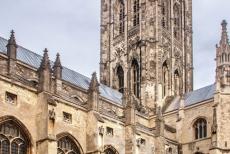
Canterbury Cathedral, Bell Harry Tower. St. Augustine founded Canterbury Cathedral in 597. Canterbury Cathedral was badly damaged during Viking raids in 1011. After a devastating fire in 1067, the cathedral was completely rebuilt from 1070 to 1077. The Norman nave and transepts were demolished in the 14th century to build the English Perpendicular Gothic structure seen today. Canterbury Cathedral was slightly damaged during the Second World War.
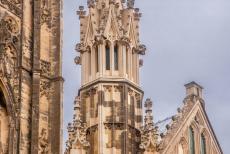
One of the pinnacles of Canterbury cathedral. All the pinnacles on the buttresses of the nave are adorned with grotesques. Grotesques, also known as chimeras, are mythical creatures. The sculpted grotesques, among them many scary looking dog heads, were intended to protect the cathedral from evil spirits. The pinnacles were built in the middle of the 19th century.
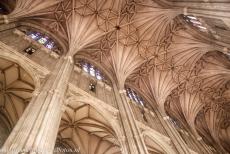
The ceiling of the nave of Canterbury Cathedral is one of the highest in the world. The nave, the western transepts and crossing tower of the cathedral were built in the English Gothic style, also known as the Perpendicular style. The style is characterized by strong vertical lines, fan vaulting, large windows and a hammerbeam roof. Canterbury Cathedral is a UNESCO World Heritage.
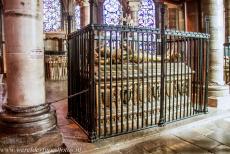
Canterbury Cathedral: Tomb of the Black Prince. The Black Prince, Edward of Woodstock, Prince of Wales, was the eldest son of Edward III of England. He was a hero at the Battles of Crécy and Poitiers, which occurred during the Hundred Years War between France and England. Edward of Woodstock is considered one of the most able generals of his time. He died in 1376, just a week before his 46th birthday. He died before he became King of England.
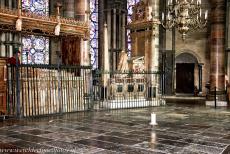
The spot where Archbishop Thomas Becket was originally interred in Canterbury Cathedral is marked with an eternal burning candle. Thomas Becket was buried inside the Trinity Chapel of Canterbury Cathedral. His tomb was destroyed in 1538, on the orders of King Henry VIII. All the bones of Thomas Becket were burnt or reburied elsewhere. The Thomas of Becket Church, close to the cathedral, preserves a small bone fragment of Thomas Becket as a relic.
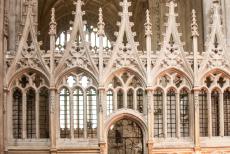
The North West transept of Canterbury Cathedral is also called the Martyrdom, it is one of the oldest parts of the cathedral and the location where Archbishop Thomas Becket was murdered. Miracles were reported soon after the murder and the cathedral became a popular pilgrimage destination, visited by thousands of pilgrims from all over Europe. Thomas Becket was declared a saint in 1173.
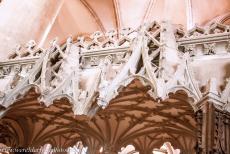
The elaborate decorations above the choir of Canterbury Cathedral. The choir was destroyed by a fire in 1174, it was rebuilt as the first Gothic building in England. The new choir was back in use again in 1180. During the Second World War, the German Luftwaffe dropped bombs on the city of Canterbury. The cathedral escaped with minor damage.
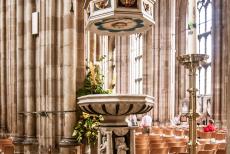
The ornate baptismal font of Canterbury Cathedral dates from 1639. The font was smashed up by Puritans in 1641, the fragments were preserved and the baptismal font was restored in 1660. The baptismal font is embellished with the finest sculptures, showing the Four Evangelists and a dove, the symbol of the Holy Spirit. The baptismal font is no longer used.

Canterbury Cathedral is situated inside the town walls of Canterbury. The cathedral is one of the oldest and one of the greatest christian buildings in England. Canterbury Cathedral is the seat of the Archbishop of Canterbury, the leader of the Church of England. St. Augustine, the founder of the cathedral, was the first the Archbishop of Canterbury.
